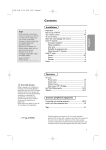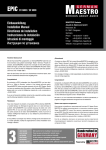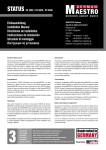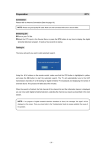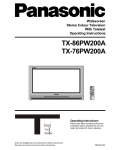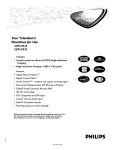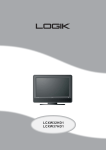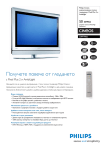Download Philips MatchLine 42PF9986 User's Manual
Transcript
Information for users in the UK (Not applicable outside the UK) Positioning the TV For the best results, choose a position where light does not fall directly on the screen, and at some distance away from radiators or other sources of heat. Leave a space of at least 5 cm all around the TV for ventilation, making sure that curtains, cupboards etc. cannot obstruct the air flow through the ventilation apertures. The TV is intended for use in a domestic environment only and should never be operated or stored in excessively hot or humid atmospheres. General Points Please take note of the section 'Tips' at the end of this booklet. Interference The Department of Trade and Industry operates a Radio Interference Investigation Service to help TV license holders improve reception of BBC and IBA programmes where they are being spoilt by interference. If your dealer cannot help, ask at a main Post Office for the booklet "How to improve Television and Radio Reception". Mains connection Before connecting the TV to the mains, check that the mains supply voltage corresponds to the voltage printed on the type plate on the rear panel of the TV. If the mains voltage is different, consult your dealer. Important This apparatus is fitted with an approved moulded 13 Amp plug. To change a fuse in this type of plug proceed as follows : 1. Remove fuse cover and fuse. 2. Fit new fuse which should be a BS1362 5A, A.S.T.A. or BSI approved type. 3. Refit the fuse cover. In order to maintain conformity to the EMC directive, the mains plug on this product must not be removed. Connecting the aerial The aerial should be connected to the socket marked x at the back of the set. An inferior aerial is likely to result in a poor, perhaps unstable picture with ghost images and lack of contrast. Makeshift or set-top aerials are unlikely to give adequate results. Your dealer will know from experience the most suitable type for your locality. Should you wish to use the set in conjunction with other equipment, which connects to the aerial socket such as TV games, or a video camera, it is recommended that you consult your dealer on the best method of connection. Stand (if provided) Use only the stand provided with the set, making sure that the fixings are properly tightened. A diagram showing how to assemble the stand is packed with the stand. Never use a make-shift stand, or legs fixed with woodscrews. Contents Help? If this instruction manual does not give an answer or if ‘Tips’ do not solve your TV problem, you can call your Local Philips Customer or Service Centre. See the supplied World-wide guarantee booklet. Please, have the Model and Product number which you can find at the back of your television set or on the packaging, ready, before calling the Philips helpline. Model: 32/37/42PF9986 Product No: ........................................... Care of the screen See Tips, p. 24. Due to continuous product improvements this manual is subject to change without notice. R End of life directives Philips is paying a lot of attention to producing environmentally-friendly in green focal areas.Your new TV contains materials which can be recycled and reused. At the end of its life specialised companies can dismantle the discarded TV to concentrate the reusable materials and to minimise the amount of materials to be disposed of. Your TV contains a (tolerated) small amount of mercury. Please ensure you dispose of your old TV according to local regulations. Preparation. . . . . . . . . . . . . . . . . . . . . . . . . . . . . . . . . . . . . 2 Keys on top of the TV . . . . . . . . . . . . . . . . . . . . . . . . . . . . . 2 Use of the remote control RC4302 . . . . . . . . . . . . . . . . . . 3 To use the menus . . . . . . . . . . . . . . . . . . . . . . . . . . . . . . . . 5 Installation . . . . . . . . . . . . . . . . . . . . . . . . . . . . . . . . . . . . . 5 Select the menu language and country . . . . . . . . . . . . . . . 5 Store TV channels. . . . . . . . . . . . . . . . . . . . . . . . . . . . . . . . 6 Automatic installation 6 Manual installation 6 Give name 7 Reshuffle the programme list 7 Select Favourite TV channels 7 TV Setup. . . . . . . . . . . . . . . . . . . . . . . . . . . . . . . . . . . . . . . 8 General 8 Source 10 Decoder 10 Demo . . . . . . . . . . . . . . . . . . . . . . . . . . . . . . . . . . . . . . . . 10 TV menu . . . . . . . . . . . . . . . . . . . . . . . . . . . . . . . . . . . . . . 11 Picture menu 11 Active Control 12 Sound 12 Ambilight 12 Features menu 13 Dual screen / PIP / Multipip . . . . . . . . . . . . . . . . . . . . . . . 14 nexTView / Teletext guide . . . . . . . . . . . . . . . . . . . . . . . . 15 Call nexTView / Teletext guide 15 nexTView guides 16 Picture/nexTView - Teletext guide 16 Teletext Guide 16 Basic functions 17 Acquisition and updating of nexTView information 17 Teletext . . . . . . . . . . . . . . . . . . . . . . . . . . . . . . . . . . . . . . . 18 Switch Teletext on and off 18 Select a Teletext page 18 Previously selected teletext page 18 Select the index teletext page 18 Select subpages 18 Enlarge a Teletext page 18 Picture/Teletext 18 Hypertext 18 Teletext menu . . . . . . . . . . . . . . . . . . . . . . . . . . . . . . . . . 19 Other equipment (satellite receiver, decoder, DVD, games, etc.)20 Connect Peripheral Equipment . . . . . . . . . . . . . . . . . . . . 20 Recorder (vcr-dvd+rw) 20 Cinema Link surround receiver 21 Connect extra subwoofer 21 Side connections 21 Multi channel Surround receiver 21 Connect your computer 22 To select connected equipment 22 Recorder or DVD with EasyLink 22 Record with your recorder with EasyLink . . . . . . . . . . . . 22 Audio- and video equipment keys . . . . . . . . . . . . . . . . . . 23 Tips . . . . . . . . . . . . . . . . . . . . . . . . . . . . . . . . . . . . . . . . . . 24 EasyLink features are based on the “one touch operation” approach. This means that a sequence of actions are executed at the same time in both the television and the recorder, provided both are fitted with the EasyLink function and connected with the eurocable supplied with your recorder. * NXT® is a trademark of New Transducers Limited 1 Preparation & Wall mounting instructions/Table stand ‘ To connect your computer, see p. 22. According to the type of TV you’ve purchased a wall mount bracket and/or stand may be supplied. How to mount the supplied stand and/or wall mount bracket, see the supplied separate leaflet. Make sure that the wall mount is being fixed securely enough so that it meets safety standards.The weight of the TV (excl. packaging) is about 20 kg (32PF9986); 27 kg (37PF9986); 35 kg (42PF9986). Note: Not supplied stands are optional accessories. Consult your dealer. é Place or hang the TV wherever you want, but make sure that air can circulate freely through the ventilation slots. Do not install the TV in a confined space such as a book case or a similar unit. To connect other peripherals, see p. 20. If you have a Cinema Link combination (Cinema Link Audio receiver and/or Cinema Link recorder and/or DVD player), see the separate supplied instruction manual, p. 27. In order to obtain the best result, please use only the supplied aerial cable between the TV and recorder, and between recorder and aerial connector. ( Insert the mains cord supplied into the mains at the bottom of the TV and in the wall socket having a mains voltage of 198-264V. To prevent damaging the power (AC) cord which could cause a fire or electric shock, do not place the TV on the cord. § Remote control: Insert the 2 batteries supplied (Type R6-1,5V). The batteries supplied do not contain the heavy metals mercury and cadmium. Please check on how to dispose of exhausted batteries according to local regulations. è Switch the TV on : Press the power switch B at the top of the TV. An indicator on the front of the TV lights up and the screen comes on. If the TV is in standby mode, press the -P+ keys or the B key on the remote control. To prevent any unsafe situations, no naked flame sources, such as lighted candles, should be placed on or in the vicinity. Avoid heat, direct sunlight and exposure to rain or water. The equipment shall not be exposed to dripping or splashing and no objects filled with liquids, such as vases, shall be placed on it. “ Insert the aerial plug firmly into the aerial socket x at the bottom of the TV. For best picture quality use the suppressor-aerial cable supplied. Keys on top of the TV Should your remote be lost or broken you can still change some of the basic settings with the keys on top of your TV. Press: • the - V + key to adjust the volume; • the - P/CH + key to select the TV channels or sources. V MENU P/CH Picture Sound Ambilight Features TV Setup Demo Install Exit 2 B Press the MENU key to summon the main menu without the remote control. Use: • the - V + key and the - P/CH + key to select menu items in the directions as shown; • the MENU key to confirm your selection. Note: When activated via the MENU key on top of the TV, only Exit lets you remove the menu. Navigate to Exit and press the MENU key. Use of the remote control RC4302 Note: For most keys pressing a key once will activate the function. Pressing a second time will de-activate it. When a key enables multiple options, a small list will be shown. Press repeatedly to select the next item in the list. The list will be removed automatically after 6 seconds or press OK to remove immediately. Remark: in DVI mode only some keys are valid. B Standby Press to switch the TV on or off. When switched off, a red indicator on the TV lights up. AMP DVD/R TV SAT AUX See ‘Audio- and Video equipment keys’, p. 23. B v Select other peripherals See p. 19. AMP DVD/R TV SAT AUX † v ®ºÒ‡π† Audio and Video equipment keys, see p. 23. Select Ò ‡ Ì º ® Instant record b ® See Record with your recorder with EasyLink, p. 22. ® OK ® U Time display Q Surround mode Incredible surround With stereo transmission, and when Incredible surround is selected, it seems as though the loudspeakers are spread further apart from one another. Virtual Dolby surround Optimal with Dolby surround signals. Enables you to experience the effect of Dolby surround Pro Logic, reproducing a rear sound effect. See Sound menu, 3D effect, p. 12. Note:You can make the same selection in the Sound menu, surround mode, p. 12. Ì Cinema Go See p. 27. æ NEXTVIEW On/Off see p. 15 • Press to switch the Pixel Plus 2 demo on or off. In the right part of the screen Pixel Plus 2 is switched on. • Press longer to display the list of digital options settings. Use the cursor up/down to select one of the settings. See also Picture menu, Digital options, p. 11. π ® æ The time is displayed on the screen. x Pixel Plus 2 demo on/off b Teletext On/Off see p. 17 ® S MENU + + V ¬ P - - 1 2 3 4 5 6 7 8 9 i 0 0 OK Press this key • to activate your choice, when in the menus. • to display the programme list. MENU Main menu on/off see p. 5 V To adjust the volume. ¬ Interrupt the sound or restore it. P Programme selection To browse through the TV channels and sources stored in the favourite list. 0/9 Digit keys Active Control b h q ON/OFF Ambilight MODE To select a TV channel. For a two digit programme number, enter the second digit before the dash disappears.To switch immediately to a selected one digit TV channel, keep the digit key pressed a bit longer. S Freeze To freeze the picture. Dependent on the input signal, the function may not be possible. 3 i On Screen information Press to display (when available) information about the selected TV channel and programme. B B AMP DVD/R TV SAT AUX † v Select Ò ‡ π ® Ì º b æ ® ® OK ® MENU + + V ¬ P - - When a menu is on screen, press i to display info on the selected menu item.While the menu info is displayed, press any key (except MENU key or digit keys) to display remote control info.The normal function of the key is not executed. 0 Smart surf / NEXTVIEW themes With this key you can easily switch between 2 up to 9 different TV channels or sources or quickly select TV programmes if NEXTVIEW with defined themes is broadcast. See General, Smart surf, p. 8. Press the OK key or wait for the time out to dismiss the Smart surf display. b Dual screen / PIP / Multipip see p. 8 and p. 14. ® S Menu/Remote control info 1 2 3 4 5 6 7 8 9 i 0 0 h Active control see p. 12. q Picture format Press this key repeatedly or press the cursor up/down to select another picture format: Auto format, Super zoom, 4:3, Movie Expand 14:9, Movie Expand 16:9, Subtitle zoom or Wide screen. Auto format Super zoom 4:3 Movie Expand 16:9 Subtitle zoom Wide screen Movie Expand 14:9 Active Control b h q ON/OFF Ambilight MODE Auto format makes the picture fill the screen as much as possible. In case of subtitles in the bottom black bar, Auto format makes the subtitles visible. In case of a broadcaster logo in the corner of the top black bar, the logo disappears from the screen. Super zoom removes the black bars on the sides of 4:3 programs with minimal distortion. When in Movie Expand 14:9, Movie Expand 16:9, Super zoom or Subtitle zoom picture format, you can make subtitles visible with the cursor up/down. Note: With signals via the DVI connector less picture formats are selectable. Ambilight see also p. 12. • ON/OFF • MODE Press to switch Ambilight on or off. Keep pressed to cycle through changing brightness settings. Press repeatedly to select one of the predefined ambient light settings. Note: When the TV is switched to standby, and you switch Ambilight On, Ambilight will be active. Only then less modes are available. 4 To use the menus & Press the MENU key on the remote control to summon the main menu. At any moment you can exit the menu by pressing the MENU key again. Note: If you have connected equipment with Cinema Link, more menu items are present. B Picture AMP DVD/R TV SAT AUX v Select Ò ‡ π ® cursor to select adjustments º b æ OK key to OK MENU ¬ P - to get Press the i key information about the selected menu item. Setup Demo Install Use the cursor left/right to select Picture, Sound, return or switch main menu on/off + + V Features Setup, Demo or Install menu. activate ® ® S Ambilight é Use the cursor in the up/down direction to select the TV, ® ® Sound TV † Ambilight or Features. Note: Sometimes not all the menu items are visible on the screen (indicated by a cluster of blue balls). Use the cursor down or right to reveal all items. “ Use the cursor in the left/right direction to select the menu item. ‘ Use the cursor up/down again to select the control you want to select or to adjust. Note: Items temporary not available or not relevant are displayed in a light grey colour and cannot be selected. Installation The installation menu contains the following items: Language Country Automatic install Manual install Give name Reshuffle Favourite programmes Install EasyLink If your recorder has an EasyLink function, during installation, the language, country and available channels are automatically transmitted to the recorder. Select the menu language and country Language Install English Deutsch Français & Press the MENU key on the remote control. é Use the cursor down to select Install. “ Use the cursor right to select Language. Follow the instructions on screen. ‘ Use the cursor up/down to select your preferred language and press the OK key to confirm your selection. Country Install Austria Belgium Croatia ( Use the cursor right to select Country. § Select the country where you are now located and press the OK key. Select Other when none of the countries applies. è Proceed with the Install menu. 5 Store TV channels After language and country are set correctly, you can now search for and store the TV channels in two different ways: using Automatic Installation or Manual Installation (tuning-in channel by channel). Select your choice with the cursor right. Automatic installation Automatic install Install Install Start & Select Automatic install in the Install menu. Note: All channels must be unlocked in order to autoprogram. If requested, enter your code to unlock all channels. (See TV, Features menu, Childlock, p. 13.) é Press the cursor down. The autoprogramming option label Start appears. “ Press the cursor right. ‘ The message Searching appears and the progress of autoprogramming is displayed. If a cable system or a TV channel which broadcasts ACI (Automatic Channel Installation) is detected, a programme list appears.Without ACI broadcast, the channels are numbered according your language and country selection.You can use Reshuffle to renumber them. See p. 7. It is possible that the cable company or the TV channel displays a broadcast selection menu. Layout and items are defined by the cable company or the TV channel. Make your choice with the cursor and press the OK key. Manual installation Manual install Install Selection mode System Programme Search Fine tune Store Searching for and storing TV channels is done channel by channel.You must go through every step of the Manual Installation menu. & Select Manual install in the Install menu. é Press the cursor down. Follow the instructions on screen. Note: Search or direct selection of a TV channel. If you know the frequency, the C- or S-channel number, enter the 3 or 2 digits of the frequency or the channel number directly with the digit keys 0 to 9 (e.g. 048). Repeat to search for another TV channel after you have stored the selected TV channel. 6 Give name Give name Install VCR1 BBC1 BBC2 CNN TVE ..... ® Space p ® Delete π ABCDEFG HIJKLMN OPQRSTU VWXYZ ® Shift 123 456 789 0 ® Special It is possible to change the name stored in the memory or to assign a name to a TV channel or external for which a name has not yet been entered. A name with up to 5 letters or numbers can be given to the programme numbers 0 to 99 and to the externals. & Select Give Name in the Install menu and press the cursor down. é Select the programme number. Note: keep the cursor up/down pressed to scroll through the programme list quickly. “ Press the cursor right. A keyboard appears on the screen. Press the cursor right to enter the keyboard. Press the cursor up/down, left/right to select the first character and press OK. Repeat for every character you want to enter. Select Space to enter a space; Delete to erase the highlighted character in the name entered; Shift to display upper- or lowercase characters on the keyboard; Special to display special characters on the keyboard. Press OK to confirm. ‘ Press the cursor left repeatedly when you have finished the name giving. ( Select another programme number and repeat steps “ to ‘. Reshuffle the programme list Reshuffle You can change the order of the stored TV channels. Install BBC1 BBC2 TV1 CNN ARD NED 1 & Select Reshuffle in the Installation menu. é Follow the instructions on screen. Select Favourite TV channels Favourite programmes Install BBC1 BBC2 TV1 CNN ARD NED 1 Yes Yes No Yes Yes No & Select Favourite programmes in the Install menu. é Select your programme number with the cursor up/down. “ Select Yes or No with the cursor right. ‘ Repeat é and “ for every TV channel or external you want to make a favourite or a non-favourite TV channel or external. 7 TV Setup General Setup Menu background Smart surf PIP format Factory settings (NEXTVIEW provider) OSD Programme title Teletext 2.5 Auto surround Subwoofer Intelligent lights Set/Change code General The Setup menu contains items that control the settings of the TV’s functions, features, services and peripherals you may have connected. The General menu allows you to change settings that will typically be accessed only occasionally. The Source menu allows you to select a source. The Decoder menu allows you to define one or more programme numbers as decoder programme numbers. This menu allows you to change various settings that are presumably adjusted less frequently than most other settings. Press the i key on the remote control to get information about the selected menu item. Menu background Select Yes or No to turn the menu background on or off. Smart surf & Select Smart surf. é With the cursor left/right, select • 2 programmes if you want the 0 key to toggle between the current and the previously selected channel, • 9 programmes if you want the 0 key to summon a list of up to 9 channels which can be selected, • Themes if you want the 0 key to quickly select TV programmes if NEXTVIEW with defined themes is broadcast. See p. 15. To add/remove a channel or source to the 9 programmes list: Tune to the channel or source you wish to add or remove. Press the 0 key and press the cursor right to add or remove. Note: If there are already 9 channels/sources in the list, the one at the bottom of the list will be removed. 8 PIP format This menu allows you to select the preferred format which can then be displayed toggling the b key on and off. & Select PIP format with the cursor down. é Press the cursor right. “ Select Dual screen, PIP, PIP 3 or PIP 6 with the cursor down. When Dual screen mode is activated with the remote control b key, and when • Dual screen is selected, the TV splits the screen into two equally sized screens. • PIP is selected, the TV shows a full screen of video with a pip window of video on top if it; • PIP3 or PIP6 is selected, the TV will display the main screen together with 3 or 6 pip screens. See also p. 14. Factory settings This resets the picture and sound settings to their predefined factory values, but maintains the channel installation settings. NEXTVIEW provider Select a TV broadcaster that provides NEXTVIEW data. How to make use of NEXTVIEW, see p. 15. OSD (On Screen Display) & Select OSD. é Select Normal to activate the continuous display of the programme number and extended display of TV channel and programme information on screen. Minimum to activate the display of reduced channel information. Note: When subtitles is switched on, see Features, p.13, display of the programme number is not possible Programme title Select Programme title Yes or No. When selected Yes, after the selection of a TV programme or after pressing the i key on the remote control, a TV channel which broadcasts teletext may transmit the name of the TV channel or the programme title. Teletext 2.5 Some broadcasters offer the opportunity to see more colours, other background colours and nicer pictures in the teletext pages. & Select Teletext 2.5. é Press the cursor right to select Teletext 2.5 On to take advantage of this feature. “ Press the cursor right again to select Teletext 2.5 Off if you like the more neutral teletext layout. The selection made is valid for all channels which broadcast teletext 2.5. Note: It may take a few seconds before teletext broadcast switches over to Teletext 2.5. Auto Surround Sometimes the broadcaster transmits special signals for Surround Sound encoded programmes. The TV automatically switches to the best surround sound mode when Auto Surround is switched On. Subwoofer Select Yes if you installed an external subwoofer. See Connect Peripheral Equipment, Connect extra subwoofer, p. 21. Intelligent lights Select Yes if you want the blue lights in the keys on top of the TV to illuminate (for a few seconds) when somebody is within 1-1,5 m of the TV. Note: As the Intelligent lights function based on reflection of moving objects, they will perform differently dependent on the environment and type/colour of clothing worn. Set/Change code The Child lock feature (see TV, Features, p. 13) allows you to lock channels to prevent others from watching certain programmes.To watch locked channels, a 4-digit code must be entered.The Set/Change code menu item allows you to create or change a Personal Identification Number (PIN). & Select Set/Change code. é If no code exists yet, the menu item is set to Set code. If a code has previously been entered, the menu item is set to Change code. Follow the instructions on screen. Important:You have forgotten your code ! & Select Change code in the General menu and press OK. é Press the cursor right and enter the overriding code 8-8-8-8. “ Press the cursor again and enter a new personal 4-digit code.The previous code is erased and the new code is stored. 9 Source Source Setup EXT1 EXT2 EXT3 DVI-I Side Centre input Centre in volume Once you have selected the source type, e.g. DVD, this source will automatically be selected when your remote control is in DVD mode, see p. 3, and when you press the v key on the remote control. This menu allows you to indicate the peripheral you connected to one of the external inputs. & Press the cursor right to enter the list of types of peripherals attached to the selected input. é Select the peripheral device with the cursor up/down. Centre input - Centre in volume When you have connected a surround receiver to the TV, see p. 21, the loudspeakers of the TV can act as centre speaker, making a separate centre speaker unnecessary. Select Centre input On. When having selected On you can adjust the Centre in volume with the cursor left/right to correct volume level differences of the external audio receiver and speakers. Note: This is not the case with a Cinema Link surround receiver. Decoder & Select Decoder with the cursor right. Decoder Setup Programme Status If a decoder or a descrambler is connected, see p. 19, you can define one or more programme numbers as decoder programme numbers. é Select Programme. “ Select the programme number under which you have stored the programme coming from your decoder. ‘ Select Status. • Select the input used to connect your decoder: None, EXT1 or EXT2. • Select None if you do not want the selected programme number being activated as a decoder programme number. Note: Select EXT2 when the decoder is connected to your EasyLink recorder. Demo TV Setup Demo Install Auto demo ...... Dealer demo - Digital options - Light sensor - 3D Y/C Comb filter The Demo menu allows to demonstrate the TV features separately or in a continuous loop. Note: Toggling through all the Ambilight modes will display each mode for 10 seconds each. Before switching to the next mode the light will first fade to off and then fade up in the next mode. If Auto demo has been selected the demo will automatically present the features sequentially in a loop. Press one of the cursor keys to stop the Auto demo. If one of the features has been selected, this particular feature demo will run only once, and the Demo menu will reappear. Note: The Dealer demo is not part of the automatic sequence and can only be activated separately. 10 TV menu Press the MENU key on the remote control to summon the main menu. Note: Dependent on the input signal, one or more menu items may not be selectable. Press the i key on the remote control to get information about the selected menu item. Picture menu Picture Sound Ambilight Features TV Smart picture Contrast Brightness Colour Sharpness Tint Digital options Dynamic contrast DNR Colour enhancement (Hue) Picture format & Press the cursor right to select Picture. é Select the menu items in the Picture menu with the cursor up/down. “ Adjust the settings with the cursor left/right or enter the list of submenu items with the cursor right. Select a submenu item with the cursor up/down. Note: To remove the menu background before adjusting the picture settings, see Select TV setup, General, p. 8. Smart picture Select Smart picture to display a list of predefined picture settings, each corresponding with specific factory settings. Personal refers to the personal preference settings of picture in the picture menu. Note: This Philips Flat TV has been set at the factory to look best in bright store environments which use fluorescent lighting. As your home will likely not be as well lit as a store, we recommend you that you cycle through the various Smart picture modes to find the one that best suits your own viewing conditions. Most consumers will find that Natural is the correct choice. Digital options Pixel Plus 2 is the most ideal setting, doubles the horizontal resolution and increases the number of lines by 33%. You may consider to select Movie Plus in case a halo effect should disturb you. Dependent on your own preference, select Progressive scan. Dynamic contrast Sets the level at which the TV automatically enhances the details in dark, middle and light areas of the picture. DNR This sets the level at which noise is measured and reduced in the picture. Colour enhancement This makes the colours more vivid and improves the resolution of details in bright colours. Hue This compensates for the colour variations in NTSC encoded transmissions. Picture format This will adjust the size of the picture dependent on the broadcast format and your preferred setting. See also use of the remote control, Picture format, p. 4. 11 Active Control The TV continuously measures and corrects all incoming signals in order to provide the best picture possible.The ambient light sensor adjusts the settings according to the viewing conditions in the room (only when having selected the Active control value Medium or Maximum). & Press the h key on the remote control. Note: switch off all menus on screen. é The Active Control menu appears. “ Press the cursor up/down to select the Active Control values Off, Minimum, Medium or Maximum. The picture settings are being optimised continuously and automatically which is displayed by bars.Those menu items can not be selected. ‘ Press the cursor right to select Smart Picture. Sound ( Press the cursor up/down to select one of the predefined picture settings. § Press the cursor right to select Active Display. è Press the cursor up/down to select Show bars, one of the Dual screen demos or Off.When you select Dynamic contrast, Pixel Plus 2, Digital Noise Reduction or Digital Natural Motion, the TV screen is divided into two parts: in the left part the selected picture quality setting is switched off; in the right part it is switched on. Note: Dependent on the input signal, one or more Dual screen demos may not be selectable. ! Press the h key again to switch off the Active Control menu. & Press the cursor right to select Sound. é Select the menu items in the Sound menu with the cursor Sound up/down and adjust the settings with the cursor left/right.Remember, control settings are at normal mid-range levels when the bar scale is centred. TV Smart sound Equalizer Volume Balance Loudness Headphone volume Surround mode (Dual I-II) (Mono/Stereo) (Nicam/Analogue) (3D effect) AVL Delta volume Smart sound Select Smart sound to display a list of predefined sound settings, each corresponding with specific factory settings of Treble and Bass. Personal refers to the personal preference settings of sound in the sound menu. Notes: - Some menu items are only available in case of a Cinema Link configuration and when the Cinema Link is activated. Others are steered by the audio receiver instead of by the TV. See Cinema Link, p. 27. - Dual X is only available with dual sound transmission. - Mono/Stereo is only selectable in case of analogue stereo transmission. - Nicam/Analogue is only selectable in case of Nicam transmission. The Ambilight menu contains options for controlling the ambient lighting at the rear of the TV. Using ambient light gives a more relaxed viewing experience and improves perceived picture quality. See also the separate supplied brochure on Optimal viewing experience. Ambilight Ambilight TV Ambilight Ambilight mode Brightness Modes (Palette) (Saturation) & Press the cursor right to select Ambilight. é Select the menu items with the cursor up/down and adjust the settings with the cursors left/right. Use the on-screen Menu-Info i for more information about the menu items. 12 Features menu Features TV Programme list Subtitle Sleeptimer Child lock On timer Off On On during mute & Press the cursor right to select Features. é Select the menu items with the cursor up/down and adjust the settings with the cursor left/right. Use the on-screen Menu-Info i for more information about the menu items. Programme list Press the OK key to switch over to the selected TV channel or external. Select subtitles The subtitle page must be stored for each TV channel: Switch on teletext and select the proper subtitle page from the index. Switch off teletext. Subtitle On will automatically display them on the selected TV channels if subtitles are in the transmission. A symbol will indicate that the mode is on. Select On during mute when you want to have the subtitles automatically displayed only when the sound has been muted with the ¬ key on the remote control. Sleeptimer This sets a time period after which the TV automatically switches to standby. Child lock & Select Child lock. Child lock Lock Custom lock Unlock “ Select one of the menu items of the child lock menu: • Lock if you want to lock all channels and externals. • Custom lock and press the cursor right. The items Age lock and Category lock are only available when NEXTVIEW broadcast is available. Select: - Age lock if you want to lock programmes related to a certain age: off, 2, 4 ... 16. - Lock after if you want to lock all programmes from a certain time onwards. Press the cursor right and enter the time with the cursor up/down and right. Press the OK key to validate. - Programme lock if you want to lock a certain TV channel or external; - Category lock if you want to lock programmes related to a certain theme: Movies, Sports, Shows.... • Select Unlock to disable all locks you have set. On timer & Select On timer with the cursor down. On timer Off On VCR1 BBC2 CNN TVE π..... Sunday Monday ....... Daily 15:45 é Select On with the cursor right. “ Press the cursor right again to enter the (Age lock) Lock after Programme lock (Category lock) ‘ ( é Press the cursor right to enter the Child lock menu.You’re summoned to enter your code. Note:You have to re-enter your code each time you enter the child lock menu. § Important:You have forgotten your code ! See p. 9. è programme list. Select the TV channel or external you want your TV to switch to on a selected time and day. Press the cursor right again to select a day of the week or to select Daily. Press the cursor right once again to enter the time with the digit keys or with the cursor up/down and press the OK key to activate. Press the MENU key to turn off the menu. Note: To check your timer settings, press the i key. 13 Dual screen / PIP / Multipip Press the b key to switch on Dual screen, PIP or one of the PIP modes according to the format selection made in the PIP format list in the General menu. See Setup, General, p. 8. Press the b key again.The screen that has a yellow border will become the full main screen picture. B AMP DVD/R TV SAT AUX † v Select Ò ‡ π ® Ì º b æ ® ® OK ® ® S MENU + + V ¬ 4 7 b i P - - 1 Notes: - Continuing to hold the b key down will cycle the TV through the various formats (Dual screen, PIP, PIP 3 or PIP 6), launching a new format after each second the key is held down. After standby of the TV, the preference as set in the Setup, General menu is used. - It is not possible to display a VGA or HD source in a Dual screen/PIP screen. - When Dual screen mode is selected, two picture formats are supported: Full screen or 4:3 letterbox picture format (vertical squeeze). - Audio from the right screen or the PIP plays to the headphones. 2 5 3 6 8 9 0 0 Active Control b h q ON/OFF Ambilight MODE Display options Dual screen PIP PIP 3 AUX AUX PIP 6 PIP1 PIP1 PIP4 PIP2 PIP2 PIP5 PIP3 PIP3 PIP6 • Press the cursor right to highlight the right screen. • Press the cursor down to highlight the single PIP screen. • Press the cursor right to enter the Multipip screen and then use the cursor keys to navigate through the PIP screens and to highlight a PIP screen. Changing TV channels or external sources in left, right, PIP or Multipip screen • Press the -P+ keys or the 0 key or the digit keys in order to change the TV channels or external sources in the highlighted screen. Scan PIP3 or PIP 6 Navigate to the lowest PIP and press the cursor down to display a following series of PIP screens. Define the position and the size of the single PIP screen & Select a Dual screen mode with a single PIP screen. é Press the cursor down to highlight the PIP screen. A PIP menu appears with which you can define the position and the size of the PIP screen. Note: When the PIP menu times out, press the OK key to make it reappear. “ Press the cursor down again to select Position or Size. 14 ‘ Press the OK key or the cursor right to activate. ( Use the cursor keys to define the position of the PIP screen. Use the cursor left/right to define the size of the PIP screen. § Press the OK key.The PIP menu reappears. è Press the cursor up to the top of the menu to highlight the main screen again. ! Press the OK key to switch off the menu or wait until it is timed out. On-Screen information The highlighted On-Screen information,which appears when changing channels, always refers to the active screen. NEXTVIEW / Teletext guide NEXTVIEW is an electronic guide that allows you to look up programmes as you would in a newspaper or a TV magazine.You can sort the programmes by subject (films, sport...), obtain detailed information and programme your recorder if it comes with the NEXTVIEWLink function. As the NEXTVIEW service is only available on certain programmes and in certain countries the NEXTVIEW service has been set default to OFF in the factory. The Teletext Programme Guide appears in its place.This is based on teletext programme information (if available) and offers most functions of NEXTVIEW. If you want to make use of the NEXTVIEW service, you may decide to switch ON the NEXTVIEW option: & Press simultaneously and continuously for at least 4 seconds, the MENU key on top of your TV and the digit key “1” on your remote control. é The TV turns to standby. “ Switch your TV on again. Additional consequences: The NEXTVIEW provider menu item and the option Themes in the Smart surf menu appear in the General Setup menu. See p. 8. Note: The broadcaster is responsible for the content of the information. To switch OFF the NEXTVIEW option again: & Press simultaneously and continuously for at least 4 seconds, the MENU key on top of your TV and the digit key “0” on your remote control. é The TV turns to standby. “ Switch your TV on again. ‘ The NEXTVIEW provider menu item and the option Themes in the Smart surf menu in the General Setup menu are no longer available. Call NEXTVIEW / Teletext guide Press the æ key on the remote control to call the NEXTVIEW/Teletext guide. A menu appears with the message One moment please. After a while you obtain: • a NEXTVIEW page, if the selected channel broadcasts this service (the NEXTVIEW logo is displayed), • a teletext page, if the selected channel does not broadcast NEXTVIEW, • No information available is displayed if neither NEXTVIEW nor teletext are transmitted. In this case, select another channel. Display of a NEXTVIEW page The information is set by the channel that transmits the General, NEXTVIEW provider, p. 8. NEXTVIEW puck Mon 05 Feb Menu Time Theme Date Programme name and broadcast time NEXTVIEW Mon 05 Feb 18.00 Channel service. See also Setup menu, Mon03 Menu guides 18.00 18.00 Channel Theme Mon03 Tue 04 BBC1 18.00 BBC News Wed 05 BBC2 18.00 The Simpsons Provider menu Thu 06 CNN 18.00 World News Fri 07 FR2 18.00 On a tout essayé! Sat 08 CH5 18.15 Tomorrow Never Dies Review Record Remind Watch Lock This logo is only displayed during a NEXTVIEW transmission or when one of the externals is selected. No logo indicates a teletext programme guide Review Record Remind Watch Lock function keys 15 NEXTVIEW guides & Use the cursor key left/right to select Time, Channel, Theme, the Date guide. The Time guide provides an overview of all programme titles active in the selected time block.The Channel guide provides an overview of all programmes that are broadcast by a single channel during one day. With the Date guide you can choose a specific date.The Theme guide displays a list of all programmes at the selected date, that matches with the selected category. Going through the menu guide, the TV is collecting the sorting criteria to finally display a list of programme events. é Press the OK key to select the guide type. “ Move the puck down and to the right to select the programmes. If available a summary or commentary on the programme is displayed at the bottom of the screen. ‘ Use the cursor up/down to scroll through the programmes. Picture/NEXTVIEW - Teletext guide & Press the æ key. Press the b key to show NEXTVIEW/Teletext guide on the right of the screen. é Use the cursor keys to select a TV channel. “ Press the b key to switch off dual screen. Teletext Guide & Enter with the digit keys, the teletext page number that contains the programme information for the current channel. é Press the cursor right to move the puck over the selection ball. “ Use the cursor up/down to scroll through the different programmes. page ball subpages selection ball BBC1 Mon 05 Feb 100 BBC2 ITV CH4 CH5 channel list Review 16.35 BBC CEEFAX LIONS RECORD ANOTHER WIN Index 100 News BBC Info 110 Headlines Children 120 Weather Cookery 150 Sports Education 200 Radio Record scroll ball 1 Remind Watch 430 300 305 400 415 500 Lock • If the selected programme contains a page number with an optional subcode referring to a page with more info about the programme, press the OK key to display the information. Press the OK key again to return to the programme guide page. • If the selected programme guide page satisfies the VPT(Video programming via Teletext) requirements, - it will be possible to record, remind, watch or lock programmes: - the TV will remember the last selected teletext page number of that channel that contains programme guide information and indicates which programme starts at what time. Every time you press the æ key, the teletext programme guide page of the selected TV channel will be available. • When necessary you can select the subpage number by moving the cursor to the pageball and pressing right. Note:You must enter the teletext pagenumber for each channel.You can change the channels also by moving the cursor up/down in the list in the left of the page. 16 Basic functions Press one of the grey x, red ®, green U, yellow Q or blue Ì keys to activate a NEXTVIEW or Teletext Guide function.The keys appear in grey if the function is not available. Review: this menu provides a list of programmes that are marked as reminders, those that have to be recorded and those that are locked.This menu can be used to change or remove marked programmes. Record: to programme the recording of the recorder (if it has a NEXTVIEWLink function and is connected to EXT2). Remind: automatically switch on the TV if it is in standby or by displaying a message if the TV is on. Lock: to lock certain programmes to prevent recording or watching. For the functions Record, Remind or Lock, a small menu pops up in which you can choose the interval: once, daily or weekly, or clear an earlier made record, remind or lock setting.The default interval is set to Once.To confirm the frequency, press the OK key. Watch: to watch the selected and currently broadcast programme. Acquisition and updating of NEXTVIEW information Acquisition and updating of NEXTVIEW is done when you are watching the TV channel of the selected NEXTVIEW provider, see Setup menu, p. 8, or when the TV is switched to standby; Acquisition of fresh data will happen once during the night. Note: it may be necessary to put the TV in standby mode when all NEXTVIEW information is outdated, e.g. when returning from holiday. 17 Teletext Most TV channels broadcast information via teletext.This TV has a 1200 pages memory that will store most broadcasted pages and subpages to reduce waiting time. After each programme change, the memory is refreshed. Switch Teletext on and off Select subpages Press b to switch the teletext on. 102 BBC CEEFAX LIONS RECORD ANOTHER WIN 430 Index 100 News BBC Info 110 Headlines Children 120 Weather Cookery 150 Sports Education 200 Radio Lottery 230 Travel Finance 240 Subtitling Music 280 TV Listings Red When a selected teletext page consists of different subpages, a list of available subpages appears on the screen. Press the cursor left or right to select the next or previous subpage. «03 04 05 06 07 08 09 10 11 12» BBC CEEFAX 102 Mon 05 Feb 16.35.22 Green Yellow 300 305 400 415 500 550 888 600 Enlarge a Teletext page Press q repeatedly to display the upper teletext part, the lower teletext part and then to return to the normal teletext page size. When the teletext page is enlarged, you can scroll the text, line by line using the cursor up/down. Blue Select a Teletext page - Enter the desired page number with the digit keys, the cursor keys up/down, left/right or with the -P+ key. - Select the options at the bottom of the screen with the colour keys. Previously selected teletext page (Only possible in case there is no list of favourite teletext pages available. See p. 19.) Press the 0 key. Picture/Teletext & Press the b key. Press the b key to show Teletext on the right of the screen. é Use the cursor keys to select a TV channel. “ Press the b key to switch off dual screen. Hypertext Select the index teletext page Press the grey colour key † to display the main index (usually p.100). Only for T.O.P teletext broadcasts : Press i. A T.O.P. overview of the teletext subjects available is displayed. Select with the cursor up/down, left/right the desired subject and press the OK key. Not all TV channels broadcast T.O.P. teletext. 18 & é “ ‘ With hypertext you can quickly jump to a pagenumber or search for a specific word shown on the current teletext page. Press the OK key to highlight the first word or a number on the page. Use the cursor up/down, left/right to select any other word or number you want to search for. Press the OK key to confirm.The search starts. A message appears at the bottom of the screen to indicate the searching, or that the word or page is not found. Use the cursor up to exit hypertext. ‘ Select Cancel to cancel the word; Space to Teletext menu & Press the MENU key to activate the menu. é Press the cursor up/down to select the menu items. “ Press the cursor right to activate. Reveal Reveals/conceals hidden information on a page, such as solutions to riddles and puzzles. Press the cursor right to activate. Favourite You may create a list of eight favourite teletext pages in total, selected from various TV channels. é Select Favourite in the teletext menu and press the cursor right to enter the list. “ Press the cursor right again to add the page. ‘ Press the MENU key to watch the current page. To watch a favourite page from the list: When in Teletext, use the 0 key to browse through the favourite pages of the TV channel actually selected. Note: only the pages of the current channel can be selected. Search Selecting a word On the keyboard on screen you can type in a random word you want to search for in the teletext pages.Whether upper- or lowercase is used has no influence. puck mo 08 may 17:08:39 Cancel Accept WORD NAME FOOTBALL Space Delete TE LETEXT A B C D E F G 1 2BBC1 3 H I J K L M N 4 5 6 O P Q R S T U 7 8 9 V W X Y Z Shift Red Green 0 Special Yellow Searching a word & Type in the word on screen or select a word from the history list on the right and press OK. é Select Accept and press OK again.The message Searching appears. “ To cancel the searching or to search for a new word, select Keyboard and press OK. ‘ When a word is not found, a message appears. To add a favourite page to the list: & Select a favourite teletext page. 102 enter a space; Delete to delete the last character selected; Shift to switch between lowercase or capital characters; Special to display special characters on the keyboard and press the OK key. ( Press the cursor left repeatedly to return to the Teletext menu again. Blue & Press the cursor right to enter the keyboard. é Press the cursor left/right, up/down to select When the word is found, it is highlighted in the teletext page.To continue the search, press the OK key. Cycle subpages (if available) Makes the subpages cycle automatically. Press the cursor right to activate and to deactivate again. Timed page To display a specific page from a selected TV channel at a certain time. & Press the cursor right and select Yes or No. é Enter the time and pagenumber with the cursor keys or the digit keys. Notes: - Teletext does not have to remain switched on, but you should watch the TV channel you have selected the specific page from. - It is not possible to display a timed page when in VGA mode. “ Press the cursor left to return to the TV menu again. Language If the displayed characters on screen do not correspond with the characters used by the teletext broadcaster, you can change the language group here. Select Group 1 or Group 2 with the cursor right. Press the MENU key to leave the Teletext menu. the characters, words or functions. “ Press the OK key to confirm each character selected. 19 Connect Peripheral Equipment There is a wide range of audio and video equipment that can be connected to your TV. The following connection diagrams show you how to connect them. Note: EXT1 can handle CVBS and RGB; EXT2 CVBS, Y/C and RGB; EXT3 CVBS; DVI can handle VGA, SVGA, XGA and 480p, 576p, 720p, 1080i and 1152i. It is preferable to connect peripherals with RGB output to EXT1 or EXT2 as RGB provides a better picture quality. Note: If your recorder is provided with the EasyLink function, it should be connected to EXT2 to benefit from the EasyLink functionality. Recorder (VCR-DVD+RW) Note: Do not place your recorder too close to the screen as some recorders may be susceptible to signals from the display. Keep a minimum distance of 0,5 m from the screen. Connect the aerial cables 1, 2 and, to obtain the optimum picture quality, eurocable 3 as shown. If your recorder does not have a euroconnector, the only possible connection is via the aerial cable.You will therefore need to tune in your recorder’s test signal and assign it programme number 0 or store the test signal under a programme number between 90 and 99, see Manual installation, p. 6. See the handbook of your recorder. CABLE EXT2 1 2 3 4 RECORDER DECODER Decoder and Recorder Connect a eurocable 4 to your decoder and to the special euroconnector of your recorder. See also the recorder handbook. See Decoder, p. 10. You can also connect your decoder directly to EXT1 or 2 with a eurocable. Other equipment (satellite receiver, decoder, DVD, games, etc.) & Connect the aerial cables 1, 2 and 3 as shown CABLE CABLE EXTERNAL 1 4 2 3 5 RECORDER 20 (only if your peripheral has TV aerial in-/output). Connect your equipment with a eurocable 4 or 5 to one of the euroconnectors EXT1, 2 or 3 to obtain a better picture quality. é Look for the test signal of your peripheral in the same way as you do for a recorder. “ Make a selection in the Setup, Source menu, p. 10. Camera or Camcorder & Connect your camera or camcorder as shown. é Connect to VIDEO 2 and AUDIO L 3 for mono equipment. For stereo equipment also connect AUDIO R 3. S-VHS quality with an S-VHS camcorder is obtained by connecting the S-VHS cables with the S-VIDEO input 1 and AUDIO inputs 3. Do not connect cable 1 and 2 at the same time. This may cause picture distortion ! Side connections AUDIO VIDEO 2 S•VIDEO 1 Headphone & Insert the plug into the headphone socket L as shown. é Press ¬ on the remote control to switch off the internal loudspeakers of the TV. The headphone impedance must be between 8 and 4000 Ohm. The headphone socket has a 3.5 mm jack. In the Sound menu select Headphone volume to adjust the headphone volume. 3 Multi channel Surround receiver & Connect the audio cable to the multi channel Surround receiver and to AUDIO OUT L and R at the bottom of your TV 1. é If you want the loudspeakers of your TV to act as centre CENTRE IN L R 2 AUDIO OUT 1 speaker, also connect an audiocable to the multi channel Surround receiver and to the CENTRE IN at the bottom of your TV 2. “ Select Centre Input On in the Source menu. See p. 10. The loudspeakers of the TV will now only produce centre sound, the loudspeakers connected to the audio receiver will produce Surround Sound.The volume has to be controlled via the multi channel Surround receiver. Note: No sound will be heard when a TV channel or external source is blocked via the Child lock menu (see p. 13). Connect extra subwoofer SUBWOOFER To enhance the sound reproduction of your TV you can connect an externally powered subwoofer (between 20 and 250 Hz). & Connect the audio cable of the external subwoofer to the SUBWOOFER socket at the rear of your TV. é Select Subwoofer in the Setup, General menu, p. 9. “ Adjust the frequency of the external subwoofer to 100120 Hz (according to your personal preference) if present on the subwoofer. ‘ Adjust the volume level of the external subwoofer, presumed this control is present on the subwoofer. See also the instruction manual of the external subwoofer. Cinema Link surround receiver See Cinema Link, p. 27. Attention: the sound info on screen will not correspond with the actual sound reproduction. 21 Connect your computer AUDIO & Connect one end of a VGA cable 1 (if necessary via a supplied VGA to DVI adaptor) to the video card of the computer and the other end to the DVI connector at the bottom of the TV. Fix the connectors firmly with the screws on the plug. é In case of a Multimedia computer, connect the audio cable 2 to the audio outputs of your Multimedia computer and to the AUDIO R (right) and L (left) inputs. DVI L R 1 The DVI connector allows the following TV and monitor display modes: EDTV 640/720 x 480p 720 x 576p HDTV 1920 x1080i 1280 x 720p VGA 640 x 480 60 Hz SVGA 800 x 600 60 Hz XGA 1024 x 768 60 Hz 2 Note: If possible, use the XGA1024x768@60Hz video mode to obtain the best image quality for your LCD monitor. To select connected equipment Press the v key on the remote control repeatedly, or select Source in the Setup menu (see p. 10) to select EXT1, EXT2, EXT3, Side or DVI according to where you connected your equipment. Remark : Most equipment (decoder, recorder) carries out the switching itself, when it is switched on. Recorder or DVD with EasyLink The recorder or DVD can be operated with the remote control via the Recorder or DVD menu on screen. & Press the MENU key on the remote control. é Select the Recorder or DVD menu with the cursor up/down. “ Press the cursor left/right, up/down to select one of the recorder or DVD functions. Recorder Ò p Rwd Play ‡ π Stop Play † Ffw ® Ï Rec Eject DVD Ò p Prev. Play ‡ π Stop Play † Ï Next Eject The key ® for recording can be operated in the TV mode. If your EasyLink recorder has the system standby function, when you press the B key for 3 seconds, both TV and the recorder are switched to standby. Record with your recorder with EasyLink In TV mode, it is possible to start a direct recording of the programme which is being displayed on the TV screen. Continue to press the ® record key on the remote control for more than 2 seconds. Note: Switching programme numbers on your TV does not disturb recording ! When recording a programme from a peripheral connected to EXT1, EXT3 or Side, you can not select another TV programme on the screen without disturbing the recording. 22 Audio- and video equipment keys This system remote control operates the following Philips equipment:TV,VCR, DVD, DVD/R, SAT (RC5/RC6), AMP (+TUNER), CD, CD/R. B AMP DVD/R TV SAT AUX † v Select Ò ‡ π ® º b æ Press the Select key to operate any of the equipment indicated in the display (AUX = CD; DVD/R = DVD, SAT = SAT (RC5). Another device can be selected by pressing Select repeatedly within 2 seconds.The led will blink slowly to indicate the device. Press one of the keys on the remote control to operate the peripheral equipment. To return to TV mode press Select while the led is blinking. When no action is taken within 60 seconds, the remote goes back to TV mode. ® ® OK ® ® S MENU + + V ¬ P - - 1 2 3 4 5 6 7 8 9 i 0 0 Active Control b h q ON/OFF Ambilight MODE When you do not want the remote to go back to TV mode, and to stay in the mode selected, proceed as follows: Select the desired mode with the Select key.Wait until no LED is lit. Press the Select key again simultaneously with the OK key for at least 2 seconds.The remote will not go back to TV mode from now on and will remain in the mode selected. To go back to the default setting of the remote (TV mode) repeat what is explained above, selecting the TV mode. Note: When the Select key is pressed and held for more than 2 seconds, the RC5/RC6 system select command is transmitted. B to switch to standby ºæ for pause (VCR, DVD, CD) RDS news/TA (AMP); to shuffle play (CD/R) ® for record Ò for rewind (VCR, CD); search down (DVD, AMP) ‡ for stop π for play † for fast forward (VCR, CD); search up (DVD, AMP) S for pause (CD/R) b RDS display (AMP); to select your choice of subtitle language (DVD); i display information Additionally the DVD/R, SAT and AUX indicator can be programmed to operate the DVD-R, DVD + receiver, DVD-R + receiver, SAT (RC6), CD-R and VCR instead. & Select TV with the Select key. é To program • DVD-R, press the OK key + digit 2; • SAT (RC6), press the OK key + digit 4; • CD-R, press the OK key + digit 6; • DVD + receiver, press the OK key + digit 7; • DVD-R + receiver, press the OK key + digit 8; • VCR, press the OK key + digit 9. MENU to switch the menu on or off for chapter, channel, track selection 0 to 9 digit entry 0 tape index (VCR), select a DVD title/chapter, select a frequency (AMP) U VCR timer -P+ cursor up/down to select the next or the previous disc (CD) cursor left/right to select the previous or following track (CD) search up/down (AMP) “ Select the corresponding DVD/R, SAT, AUX indicator.The remote control will operate your DVD-R, DVD or DVD-R in combination with a receiver (DVD/R), SAT (RC6) (SAT), CD-R or VCR (AUX). Note: To return to the modes programmed in the factory, either remove the batteries for a few minutes, or press the OK key + digit 1 (DVD mode); or + digit 3 (SAT-RC5) or + digit 5 (CD mode). 23 Tips Care of the screen Do not touch, push or rub or strike the screen with anything hard as this may scratch, mar or damage the screen permanently. And please do not rub with dust clothes with chemical treatment. Do not touch the surface with bare hands or greasy cloth (some cosmetics are detrimental to the screen). Unplug the TV before cleaning the screen. When the surface becomes dusty, please wipe gently with absorbent cotton or other soft materials like chamois soaks. Do not use acetone, toluene and alcohol because they cause chemical damage. Do not use liquid cleaners or aerosol cleaners. Wipe off saliva or water drops as soon as possible.Their long time contact with the screen causes deformations and colour fading. Poor Picture • Have you selected the correct TV system in the manual installation menu? • Is your TV or house aerial located too close to loudspeakers, non-earthed audio equipment or neon lights, etc.? • Mountains or high buildings can cause double pictures or ghost images. Sometimes you can improve the picture quality by changing the direction of the aerial. • Is the picture or teletext unrecognisable? Check if you have entered the correct frequency. See Installation, Manual installation, p. 6. • Are brightness, sharpness and contrast out of adjustment? Select Factory settings in the Setup, General menu, p. 8. No Picture • Are the supplied cables connected properly ? (The aerial cable to the TV, the other aerial to your recorder, the VGA cables to the display, the power cables.) • Has the child lock been switched off ? • Is your PC switched on ? • Do you see a black screen and the indicator in front of the TV lights up blue, this means that the display mode is not supported. Switch your VGA-source to a correct display mode. • In case of weak or bad signal, consult your dealer. Digital distortion The low quality of some digital picture material may be the cause of digital image distortion. In this case select the Soft setting using the Picture menu, Smart Picture, without changing the picture settings manually. No sound • No sound on any channel? Check the volume isn’t at minimum. • Is the sound interrupted with the mute key ¬? No solution found Switch your TV off and then on again once. Never attempt to repair a defective for your picture or TV yourself. Check with your dealer or call a TV technician. sound problem ? NEXTVIEW No NEXTVIEW info: See Acquisition and updating of NEXTVIEW information, p. 17. Displayed time is wrong: The broadcaster on programme number one does not transmit the correct local date and time. Use Reshuffle in the installation menu to place another broadcaster on programme number one. 24 Remote control • Check if the remote control is in the correct mode. • If your TV no longer responds to the remote control, the batteries may be dead. • You can still use the MENU key and the -/+ keys on top of your TV. Standby Your TV consumes energy in the standby mode. Energy consumption contributes to air and water pollution. Power consumption: 2 W. No stable or not synchronised VGA picture Check if you have selected the correct VGA mode in your PC. Miscellaneous See Extras, Specifications on this CD. 25 26 VCR TV VCR IN TV IN EXT 2 CENTRE IN AUDIO DIGITAL IN CINEMA VCR LINK IN TV IN CENTRE OUT 2 1 4 3 Recorder DVD VCR TV VCR IN TV IN EXT 2 AUDIO DIGITAL IN 3 CINEMA VCR LINK IN 4 TV IN CENTRE OUT 2 1 Recorder DVD CENTRE IN Recommended: Do not use the AC outlet at the back of the audio receiver to power the DVD or the video recorder in a Home Cinema configuration. English Note: The Cinema Link functionality is only available with devices of the Cinema Link (P50.3) generation ! Cinema Link is a new Philips feature in which the TV, the audio receiver and other video peripherals communicate with each other (on condition they all are equipped with the Cinema Link functionality and are connected via a eurocable).They automatically offer the highest quality combination of picture and multi channel surround sound to create your own Home Cinema. With one key on the remote control, with which you can control all Cinema Link products, your total Cinema Link system will be started and the DVD or video recorder will start to play and the audio receiver will provide the sound (on the condition Cinema link is enabled) on behalf of the TV. The TV or monitor can function as the centre speaker of your system, making a separate centre speaker unnecessary (only in case your TV or receiver box is equipped with a Centre IN connector). By pressing the standby key B on the remote control for at least 3 seconds, the complete Cinema Link system will be switched to standby. Configuration of the Cinema Link peripherals The connection diagram in the inside cover shows you how to connect the Cinema Link peripherals with each other. Notes: - Besides the TV or receiver box at least one peripheral should be provided with the Cinema Link functionality to benefit from this feature. - To take advantage of the highest quality of multi channel Surround sound it is advisable that you have a Cinema Link audio receiver connected. - The peripherals connected don’t need to see the TV remote control in the Cinema Link system. The commands given to the TV are automatically passed to the other peripherals. This allows you to put the peripherals behind the doors of a cabinet or to place them in another room. - To enjoy Digital Surround playback, the digital device (e.g. DVD) should be connected to the digital input of the audio receiver with a separate cinch audio cable 4. In case your TV is provided with a DIGITAL AUDIO OUT connector, also connect it to one of the digital input connectors of your audio receiver 5. If you connect the digital audio output connector of your TV and/or peripheral equipment to a digital input connector of your audio receiver 4 and 5 (if present), select the appropriate digital input (1 or 2) in your audio receiver. - The optional wireless speakers of the TV cannot be used. Preparation and Operation & Cinema Link is switched on as soon as the audio receiver and the TV are switched on. If necessary, Cinema Link may be switched off or on again only on the audio receiver. See the instructions for use of your audio receiver. Important: When Cinema Link is switched on all audio commands control the audio receiver instead of the TV. é The message CINEMALINK ON is displayed on the audio receiver and on the TV. Now the CinemaLink system is activated. Note: it is recommended to disable CinemaLink when the receiver is used to record a CD e.g. or when using a headphone when others are watching TV. Now you can adjust the initial TV settings for optimal surround sound and install the audio channels before starting up one of the CinemaLink devices.The system information about country choice, menu language and picture format you set up during the installation of the TV is transferred to the audio receiver automatically. TV as centre speaker (only in case your TV or receiver box is equipped with a Centre IN connector) See the Instructions for Use of the TV or receiver box, Setup, Source menu, Centre input. Use the test tone function in the Speakers menu to have a reference of the loudness of the separate speakers. Note: If you want the loudspeakers of your TV or monitor to act as centre speaker, also connect a cinch audio cable (not supplied) 2 to the CENTRE IN connector of your TV or receiver box. 1 Activating CinemaLink Continue to press the Ì-key on the remote control for more than 4 seconds. & The TV or receiver box sends a play command to the Cinema Link DVD player, if present. é The DVD player will start playing and the audio receiver automatically switches to the best Cinema Link sound. “ If no DVD player is connected or if the DVD player has no disc loaded, the command can not be executed. ‘ The TV or receiver box will then send a play command to the Cinema Link video recorder, if present. ( The video recorder will start playing and the audio receiver selects the best Cinema Link sound. § If no video recorder source is connected or tape is loaded, the TV or receiver box will select the last watched TV channel. Receiver menu TV DVD Recorder Receiver Setup Demo Install Sound Surround Speakers Automatic Manual Give name installation installation Reshuffle Note: When Cinema Link is enabled, certain items of the Sound menu (see TV menu) are steered by the audio receiver instead of by the TV or receiver box. & Press é Press “ Press ‘ Press the the the the MENU key on the remote control. cursor down to select Receiver. cursor right to enter the Receiver menu items. cursor up/down to select the submenu items. Note: the audio receiver submenu items may only be selected if provided by the audio receiver (dependent on the configuration setup and the sound signals transmitted). Sound menu Dependent on the audio receiver speakers configuration, you may not be able to select certain menu items. Sound Receiver Smart Sound Treble Bass Loudness 3D effect Night mode Audio Only 2 Smart Sound,Treble, Bass See the Instructions for Use for the TV or receiver box. Loudness When Loudness On is selected and when listening at low volume, the low and high frequencies are amplified so that the natural balance is restored. 3D effect 3D effect enables you to experience the effect of Dolby Surround Pro Logic without the need of having rear speakers connected or activated. Select the level of 3D effect with the cursor left/right. Night mode (only functional with Dolby Digital sound broadcasting input) The loud parts of the sound are lowered and the soft passages are raised. You can enjoy surround sound without disturbing sleeping children or neighbours. Audio only This control enables you to blank the TV picture if the TV or monitor is used as centre speaker in the Cinema Link system and if the audio receiver is reproducing sound unrelated to a TV picture. Switch Audio only On to only hear the sound and to switch off the picture. The message Audio only appears on screen. Surround menu Dependent on the audio receiver speakers configuration, you may not be able to select certain menu items. Adjustment of the volume level of the loudspeakers Surround Note: the test tone function is automatically cancelled by the audio Receiver receiver when leaving the Surround menu. Test Tone Front left volume Front right volume Centre volume Rear volume Rear left volume Rear right volume Subwoofer volume & Select Test Tone On. A steady noise tone is switched sequentially through the available loudspeakers, except for the subwoofer, for 2 seconds each.This enables you to have a reference of the loudness of each loudspeaker and to adjust the level of each until they all sound equally loud. The loudspeakers activated light up in the screen graphic. é Select the Surround menu items with the cursor up/down one after another and alter the selected adjustments with the cursor left/right. The best result is achieved when all speakers have equal volume in your usual listening position. “ Select Test tone Off when you have finished the adjustment of the speaker levels. Speakers menu Dependent on the audio receiver speakers configuration, you may not be able to select certain menu items. Once the number and position of the loudspeakers has been fixed, selecting Centre speaker, Rear Speakers and Subwoofer Yes or No, you can adjust the initial receiver settings, size and distance, for optimal surround sound. Note: after changing the configuration, the menu will disappear temporarily and re-appear again after the new settings will be updated. Speakers Receiver Centre speakers Rear speakers Subwoofer present Front speaker size Centre speaker size Rear speaker size Distance to front Distance to centre Distance to rear Yes/No Yes/No Yes/no Large/Small Large/Small Large/Small 1-10 m 1-10 m 1-10 m Size of the speakers Select Small if your speaker is able to reproduce low notes down to at least 80-100 Hz. Select Large if your speaker is able to reproduce low notes down to at least 50 Hz. Note: - As a rule of thumb, a large speaker has a cone diameter of at least 12 cms (5 inches). See the specification sheet of your loudspeakers. - If Subwoofer present is set to No, Front speaker size can only be set to Large. If Front speaker size is set to Small, Centre speaker size can only be set to Small and consequently a subwoofer must be connected. Distance to the speakers Select the distance from your usual listening position to the available speakers each; front, centre and rear speakers. This defines the delay time for the surround sound. 3 Automatic installation Automatic install In the Automatic installation menu select Start to activate the automatic searching of all radio stations which can be received. The programme list is automatically filled with all the numbers and names of the radio stations transmitted. Receiver Install Start Manual installation Manual install You can also search for a known radio station by keying in the frequency. Receiver Band Search Preset Store LW MW SW FM AM & First select Band to switch to the desired waveband: LW, MW, SW, FM or AM. é Select Search and press the cursor right. The frequency increases until a radio station is found. If you know the 3-digit frequency, enter it directly with the digit keys 0 to 9. Select Preset to enter the preset number using a three digit entry with the digit keys. “ To store your radio station, select Store and press the OK key. ‘ Repeat steps & to “ to store another radio station. Give name - Reshuffle Give name Reshuffle Receiver To assign or change a name to a radio station or to change the order of the stored radio stations according to your preference, act in the same way as with giving a name or reshuffling the programme list of TV channels. See the Instructions for Use of the TV or receiver box. 4 Table of TV frequencies. Frequenztabelle der Fernsehsender. Liste des fréquences des émetteurs. Frequentietabel TV-Zenders. Tabella delle frequenze delle trasmittenti. Lista de las frecuencias de las emisoras. Lista das frequências dos emissores. Liste over TV senderne. Tabell over TV-frekvenser. EUROPE CH ..FREQ (MHz) E2.............48.25 E3.............55.25 E4.............62.25 E5...........175.25 E6...........182.25 E7...........189.25 E8...........196.25 E9...........203.25 E10.........210.25 E11.........217.25 E12.........224.25 S1...........105.25 S2...........112.25 S3...........119.25 S4...........126.25 S5...........133.25 S6...........140.25 S7...........147.25 S8...........154.25 S9...........161.25 S10.........168.25 S11.........231.25 S12.........238.25 S13.........245.25 S14.........252.25 S15.........259.25 S16.........266.25 S17.........273.25 S18.........280.25 S19.........287.25 S20.........294.25 H1 ..........303.25 H2 ..........311.25 H3 ..........319.25 H4 ..........327.25 H5 ..........335.25 H6 ..........343.25 H7 ..........351.25 H8 ..........359.25 H9 ..........367.25 H10 ........375.25 H11 ........383.25 H12 ........391.25 H13 ........399.25 H14 ........407.25 H15 ........415.25 H16 ........423.25 H17 ........431.25 H18 ........439.25 H19 ........447.25 21 ...........471.25 22 ...........479.25 23 ...........487.25 24 ...........495.25 25 ...........503.25 26 ...........511.25 27 ...........519.25 28 ...........527.25 29 ...........535.25 30 ...........543.25 31 ...........551.25 32 ...........559.25 33 ...........567.25 34 ...........575.25 35 ...........583.25 36 ...........591.25 37 ...........599.25 38 ...........607.25 39 ...........615.25 40 ...........623.25 41 ...........631.25 42 ...........639.25 43 ...........647.25 44 ...........655.25 45 ...........663.25 46 ...........671.25 47 ...........679.25 48 ...........687.25 49 ...........695.25 50 ...........703.25 51 ...........711.25 52 ...........719.25 53 ...........727.25 54 ...........735.25 55 ...........743.25 56 ...........751.25 57 ...........759.25 58 ...........767.25 59 ...........775.25 60 ...........783.25 61 ...........791.25 62 ...........799.25 63 ...........807.25 64 ...........815.25 65 ...........823.25 66 ...........831.25 67 ...........839.25 68 ...........847.25 69 ...........855.25 Tabell över TV-frekvenser. TV-taajuustaulukko. Kατάλογος συχνοτήτων ποµπών. Spisok hastot peredathikov. A televizió−adóállomások frekvenciáinak a listája. Lista częstotliwości stacji nadawczych. Seznam frekvenčních pásem vysílačů. Zoznam frekvenčných pásiem vysielačov. E-EUROPE FRANCE ITALY CAN..FREQ (MHz) R1 ..........49.75 R2 ..........59.25 R3 ..........77.25 R4 ..........85.25 R5 ..........93.25 R 6 .......175.25 R 7 .......183.25 R 8 .......191.25 R 9 .......199.25 R10 ......207.25 R11 ......215.25 R12 ......223.25 S1 ........105.25 S2 ........112.25 S3 ........119.25 S4 ........126.25 S5 ........133.25 S6 ........140.25 S7 ........147.25 S8 ........154.25 S9 ........161.25 S10 ......168.25 S11 ......231.25 S12 ......238.25 S13 ......245.25 S14 ......252.25 S15 ......259.25 S16 ......266.25 S17 ......273.25 S18 ......280.25 S19 ......287.25 S20 ......294.25 H1 ........303.25 H2 ........311.25 H3 ........319.25 H4 ........327.25 H5 ........335.25 H6 ........343.25 H7 ........351.25 H8 ........359.25 H9 ........367.25 H10 ......375.25 H11 ......383.25 H12 ......391.25 H13 ......399.25 H14 ......407.25 H15 ......415.25 H16 ......423.25 H17 ......431.25 H18 ......439.25 H19 ......447.25 21 .........471.25 22 .........479.25 23 .........487.25 24 .........495.25 25 .........503.25 26 .........511.25 27 .........519.25 28 .........527.25 29 .........535.25 30 .........543.25 31 .........551.25 32 .........559.25 33 .........567.25 34 .........575.25 35 .........583.25 36 .........591.25 37 .........599.25 38 .........607.25 39 .........615.25 40 .........623.25 41 .........631.25 42 .........639.25 43 .........647.25 44 .........655.25 45 .........663.25 46 .........671.25 47 .........679.25 48 .........687.25 49 .........695.25 50 .........703.25 51 .........711.25 52 .........719.25 53 .........727.25 54 .........735.25 55 .........743.25 56 .........751.25 57 .........759.25 58 .........767.25 59 .........775.25 60 .........783.25 61 .........791.25 62 .........799.25 63 .........807.25 64 .........815.25 65 .........823.25 66 .........831.25 67 .........839.25 68 .........847.25 69 .........855.25 CAN..FREQ (MHz) 2 ..............55.75 3 ..............60.50 4 ..............63.75 5 ..............176.0 6 ..............184.0 7 ..............192.0 8 ..............200.0 9 ..............208.0 10 ............216.0 B............116.75 C............128.75 D............140.75 E ............159.75 F ............164.75 G ...........176.75 H............188.75 I .............200.75 J ............212.75 K............224.75 L ............236.75 M...........248.75 N ...........260.75 O ...........272.75 P ............284.75 Q ...........296.75 H1..........303.25 H2..........311.25 H3..........319.25 H4..........327.25 H5..........335.25 H6..........343.25 H7..........351.25 H8..........359.25 H9..........367.25 H10........375.25 H11........383.25 H12........391.25 H13........399.25 H14........407.25 H15........415.25 H16........423.25 H17........431.25 H18........439.25 H19........447.25 21 ..........471.25 22 ..........479.25 23 ..........487.25 24 ..........495.25 25 ..........503.25 26 ..........511.25 27 ..........519.25 28 ..........527.25 29 ..........535.25 30 ..........543.25 31 ..........551.25 32 ..........559.25 33 ..........567.25 34 ..........575.25 35 ..........583.25 36 ..........591.25 37 ..........599.25 38 ..........607.25 39 ..........615.25 40 ..........623.25 41 ..........631.25 42 ..........639.25 43 ..........647.25 44 ..........655.25 45 ..........663.25 46 ..........671.25 47 ..........679.25 48 ..........687.25 49 ..........695.25 50 ..........703.25 51 ..........711.25 52 ..........719.25 53 ..........727.25 54 ..........735.25 55 ..........743.25 56 ..........751.25 57 ..........759.25 58 ..........767.25 59 ..........775.25 60 ..........783.25 61 ..........791.25 62 ..........799.25 63 ..........807.25 64 ..........815.25 65 ..........823.25 66 ..........831.25 67 ..........839.25 68 ..........847.25 69 ..........855.25 CAN..FREQ (MHz) A ..............53.75 B ..............62.25 C ..............82.25 D ............175.25 E ............183.75 F.............192.25 G............201.25 H ............210.25 H1 ..........217.25 S1 ..........105.25 S2 ..........112.25 S3 ..........119.25 S4 ..........126.25 S5 ..........133.25 S6 ..........140.25 S7 ..........147.25 S8 ..........154.25 S9 ..........161.25 S10 ........168.25 S11 ........231.25 S12 ........238.25 S13 ........245.25 S14 ........252.25 S15 ........259.25 S16 ........266.25 S17 ........273.25 S18 ........280.25 S19 ........287.25 S20 ........294.25 H1 ..........303.25 H2 ..........311.25 H3 ..........319.25 H4 ..........327.25 H5 ..........335.25 H6 ..........343.25 H7 ..........351.25 H8 ..........359.25 H9 ..........367.25 H10 ........375.25 H11 ........383.25 H12 ........391.25 H13 ........399.25 H14 ........407.25 H15 ........415.25 H16 ........423.25 H17 ........431.25 H18 ........439.25 H19 ........447.25 21...........471.25 22...........479.25 23...........487.25 24...........495.25 25...........503.25 26...........511.25 27...........519.25 28...........527.25 29...........535.25 30...........543.25 31...........551.25 32...........559.25 33...........567.25 34...........575.25 35...........583.25 36...........591.25 37...........599.25 38...........607.25 39...........615.25 40...........623.25 41...........631.25 42...........639.25 43...........647.25 44...........655.25 45...........663.25 46...........671.25 47...........679.25 48...........687.25 49...........695.25 50...........703.25 51...........711.25 52...........719.25 53...........727.25 54...........735.25 55...........743.25 56...........751.25 57...........759.25 58...........767.25 59...........775.25 60...........783.25 61...........791.25 62...........799.25 63...........807.25 64...........815.25 65...........823.25 66...........831.25 67...........839.25 68...........847.25 69...........855.25 GB The frequencies used by a cable company may differ from the frequencies on the table. Consult your cable company or your dealer for detailed information. D In Kabelfernsehanlagen können Abweichungen von den in den Frequenztabellen aufgeführten Frequenzen vorkommen. Bitte wenden Sie sich an Ihren Fachhändler oder Ihre Kabelfernsehgesellschaft, die Ihnen die zutreffenden Frequenzen mitteilt. F Les fréquences utilisées par une société de télédistribution peuvent être différentes de celles sur la liste des fréquences. Consultez votre société de télédistribution ou votre revendeur pour des informations plus détailées. NL De frequenties die gebruikt worden door een kabelmaatschappij kunnen verschillen van deze op de tabel. Raadpleeg uw kabelexploitant of uw handelaar voor meer informatie. I Le frequenze usate per una società di teledistribuzione possano essere differenti di quelle nella tabella. Consultate la società di teledistribuzione o il vostro rivenditore per informazione specifica. E Las frecuencias utilizadas por las empresas de distribución de señal por cable, pueden ser diferentes de las que se encuentran en esta tabla. Consulte con su compañia de distribución de televisión por cable o con su distribuidor para que le proporcionen una información más detallada. P As frequências utilizadas por uma sociedade de teledistribuição podem ser diferentes das indicadas na lista de frequências. Consultar a sociedade de teledistribuição ou o vendedor para informações mais detalhadas. DK Frekvenser benyttet af kabel operatører kan være afvigende fra disse, kantakt deres kabel operatør eller forhandler for næmere informa-tion. N Frekvensene som benyttes pa et kabelnett kan avvike fra de som er oppfört i tabellen. Kontakt ditt kabel-TV selskap eller din forhandler for næmere opplysninger. S Frekvenserna som används i kabel-TV-näten kan avvika från frekvenserna i tabellen. Kontakta ditt kabel-TV-bolag eller din radiohandlare för vidare information. SF Kaapeliyhtiöden käyttämät taajuudet voivat poiketa taulukossa olevista taajuuksista. Tarkat tiedot saat kaapeliyhtiösta tai myyjältä. GR Οι συχντητες που χρησιµοποιούνται απ µια εταιρεία τηλεµετάδοσης είναι δυνατν να είναι διαφορετικές απ αυτές που περιέχει ο κατάλογος. (Συµβουλευθείτε την εταιρεία τηλεµετάδοσης ή τον πωλητή για λεπτοµερέστερες πληροφορίες). CEI Hastoty na kotoryx peredaòt telakampaniä mogut otlihatæsä ot hastot na dannoj tablice. (Obratitæsä k Vaπej telekampanii ili Vaπemu prodavcu za dopolnitelænoj informaciej. H Egy televizió−adóállomás sugárzáshoz használt frekvenciatar− tományai lehetnek a táblázatban közöltektől eltérőek is. (Abban az esetben, ha bővebb információkra van szüksége, forduljon az eladóhoz.) PL Operator sieci telewizyjnej może stosować inne częstotliwości, niż te, które figurują na tablicy (bardziej szczegółowych infor− macji na ten temat zasięgnąć u operatora lub sprzedawcy). CZ Frekvence používané některými televizními společnostmi se mohou lišit od údajů uvedených v tomto seznamu. Informujte se blíže u příslušné společnosti nebo v prodejně, kde jste televizor koupili. SK Frekvencie používané niektorými spoločnos9ami televízneho prenosu sa môžu liši9 od údajov uvedených v tomto zozname. Informujte sa bližšie u príslušnej spoločnosti alebo v predajni, kde ste televízor kúpili.













































